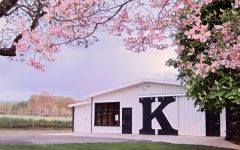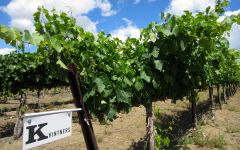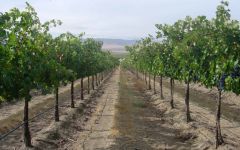K Vintners King Coal 2017
-
Jeb
Dunnuck -
Robert
Parker -
James
Suckling



Product Details
Your Rating
Somm Note
Winemaker Notes
2017 was a fantastic year for making wine with a cool spring and a fair amount of rain. Washington had an ideal spring for heathy vines. The moderate temperatures during summer were perfect for small clusters and yet delayed veraison into the fall where we had a consistent ripening season that allowed us to hang the fruit for perfect tannin and flavor without losing acidity or acquiring too much alcohol. Overall it was a vintage to remember.
Blend: 80% Cabernet Sauvignon, 20% Syrah
Professional Ratings
-
Jeb Dunnuck
One of the top two or three wines in the vintage, I was blown away by the 2017 King Coal, which comes all from the Stoneridge Vineyard on the Royal Slope and is 80% Cabernet Sauvignon and 20% Syrah. The Syrah is not destemmed, and everything is co-fermented in oak uprights and aged in 60% new barrels. Brilliant on all accounts, with a huge nose of spiced red and black fruits, chocolate, cured meats, tobacco, and truffle, it hits the palate with full-bodied richness, awesome tannins, a great mid-palate, and a finish that won’t quit. The Syrah component gives this plenty of upfront appeal, yet it’s going to cruise in cold cellars for 15 years or more.
-
Robert Parker's Wine Advocate
A blend of 80% Cabernet Sauvignon and 20% Syrah, the 2017 King Coal Stoneridge Vineyard begins as a classic Cabernet with generous oak tones in the glass. Full-bodied, the wine is rich and round with a velvety mouthfeel that is just slightly softer than previous vintages but persists with the same generous expression, with a rustic minerality, sweet oak core and evident flavors of green pepper and dried tobacco spice. The wine continues to somersault with an evolving and layered long, drawn-out and silky finish. Well done!
-
James Suckling
This is a juicy, flavorful red with a filled-out palate of ripe-berry and chocolate character. It’s full-bodied with round, soft tannins and a flavorful finish. A blend of 80% cabernet sauvignon and 20% syrah. Drink or hold.
Other Vintages
2020-
Robert
Parker -
James
Suckling -
Jeb
Dunnuck
-
Jeb
Dunnuck -
James
Suckling -
Robert
Parker -
Wine
Spectator
-
Jeb
Dunnuck -
James
Suckling -
Robert
Parker -
Wine
Spectator
-
Jeb
Dunnuck -
Robert
Parker -
Wine
Enthusiast
-
Robert
Parker -
James
Suckling
-
Robert
Parker -
Wine
Spectator






Located at the base of the Blue Mountains in Walla Walla Washington, K Vintners opened its doors to the public on December 3rd, 2001. The property at 820 Mill Creek Road where the winery sits was homesteaded in 1853 with the adjacent farmhouse built in 1872. The winery grounds with Titus Creek flowing through the lawn and the old pioneer planted trees, is a little slice of heartland Americana. The Winemaker: He loves to drink wine! Charles Smith, proprietor and winemaker, comes to Walla Walla after 11 years in Scandanavia. Originally from northern California, he has been involved with wine personally and professionally his whole life. And did we forget to mention... he loves to drink wine! The Vineyards: K Vintners is producing wines from 2 distinctive viticultural zones: Wahluke Slope and Walla Walla Valley. Each of these areas are unique and awesome for Syrah and the Field Blends produced. In April '02 two seperate blocks of vineyards were planted to Syrah adjacent to the winery in the rocky dry creek beds that run through K Vintners property.

With hundreds of red grape varieties to choose from, winemakers have the freedom to create a virtually endless assortment of blended red wines. In many European regions, strict laws are in place determining the set of varieties that may be used, but in the New World, experimentation is permitted and encouraged resulting in a wide variety of red wine styles. Blending can be utilized to enhance balance or create complexity, lending different layers of flavors and aromas. For example, a red wine blend variety that creates a fruity and full-bodied wine would do well combined with one that is naturally high in acidity and tannins. Sometimes small amounts of a particular variety are added to boost color or aromatics. Blending can take place before or after fermentation, with the latter, more popular option giving more control to the winemaker over the final qualities of the wine.
How to Serve Red Wine
A common piece of advice is to serve red wine at “room temperature,” but this suggestion is imprecise. After all, room temperature in January is likely to be quite different than in August, even considering the possible effect of central heating and air conditioning systems. The proper temperature to aim for is 55° F to 60° F for lighter-bodied reds and 60° F to 65° F for fuller-bodied wines.
How Long Does Red Wine Last?
Once opened and re-corked, a bottle stored in a cool, dark environment (like your fridge) will stay fresh and nicely drinkable for a day or two. There are products available that can extend that period by a couple of days. As for unopened bottles, optimal storage means keeping them on their sides in a moderately humid environment at about 57° F. Red wines stored in this manner will stay good – and possibly improve – for anywhere from one year to multiple decades. Assessing how long to hold on to a bottle is a complicated science. If you are planning long-term storage of your reds, seek the advice of a wine professional.

A large and geographically diverse AVA capable of producing a wide variety of wine styles, the Columbia Valley AVA is home to 99% of Washington state’s total vineyard area. A small section of the AVA even extends into northern Oregon!
Because of its size, it is necessarily divided into several distinctive sub-AVAs, including Walla Walla Valley and Yakima Valley—which are both further split into smaller, noteworthy appellations. A region this size will of course have varied microclimates, but on the whole it experiences extreme winters and long, hot, dry summers. Frost is a common risk during winter and spring. The towering Cascade mountain range creates a rain shadow, keeping the valley relatively rain-free throughout the entire year, necessitating irrigation from the Columbia River. The lack of humidity combined with sandy soils allows for vines to be grown on their own rootstock, as phylloxera is not a serious concern.
Red wines make up the majority of production in the Columbia Valley. Cabernet Sauvignon is the dominant variety here, where it produces wines with a pleasant balance of dark fruit and herbs. Wines made from Merlot are typically supple, with sweet red fruit and sometimes a hint of chocolate or mint. Syrah tends to be savory and Old-World-leaning, with a wide range of possible fruit flavors and plenty of spice. The most planted white varieties are Chardonnay and Riesling. These range in style from citrus and green apple dominant in cooler sites, to riper, fleshier wines with stone fruit flavors coming from the warmer vineyards.
